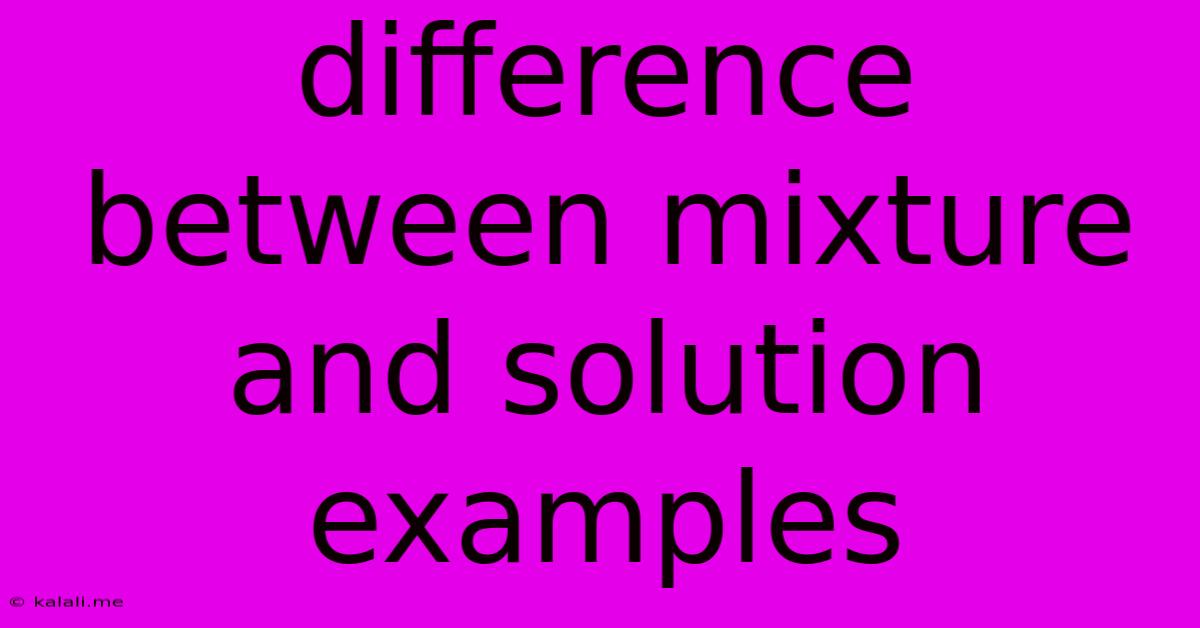Difference Between Mixture And Solution Examples
Kalali
Jun 15, 2025 · 3 min read

Table of Contents
The Difference Between Mixtures and Solutions: A Comprehensive Guide with Examples
Understanding the difference between mixtures and solutions is fundamental in chemistry and everyday life. While both involve combining two or more substances, the key lies in the way these substances are combined at a molecular level and the resulting properties. This article will explore the differences between mixtures and solutions, providing clear examples to solidify your understanding.
What is a Mixture?
A mixture is a combination of two or more substances that are physically combined but not chemically combined. This means that the individual substances retain their original chemical properties and can be separated by physical methods like filtration, distillation, or evaporation. Mixtures can be homogeneous (uniform composition throughout) or heterogeneous (non-uniform composition).
Types of Mixtures:
-
Heterogeneous Mixtures: These mixtures have visibly different parts. You can easily see the individual components. Examples include:
- Sand and water: The sand particles are clearly visible and settle at the bottom.
- Oil and water: The oil and water layers separate distinctly.
- Salad: A salad contains various vegetables and other ingredients, each retaining its identity.
- Pizza: A classic example showing different ingredients readily identifiable.
-
Homogeneous Mixtures: These mixtures have a uniform composition throughout. The individual components are not visibly distinguishable. Examples include:
- Saltwater: Salt dissolves completely in water, creating a uniform solution. However, it’s important to note that while seemingly uniform, saltwater is technically a mixture before we delve into solutions.
- Air: A mixture of various gases, including nitrogen, oxygen, and carbon dioxide.
- Sugar dissolved in water: The sugar dissolves completely, forming a uniform solution (again, technically a mixture at this stage).
- Many alloys: Such as brass (copper and zinc)
What is a Solution?
A solution is a special type of homogeneous mixture where one substance (the solute) is dissolved uniformly within another substance (the solvent). The solute particles are dispersed at a molecular level, meaning they are individually surrounded by solvent molecules. Solutions are typically transparent, and the solute cannot be easily separated by simple physical means.
Key Characteristics of Solutions:
- Homogeneous: Uniform composition throughout.
- Transparent: Light can pass through without significant scattering.
- Solute particles are invisible: Individual solute particles are not visible to the naked eye.
- Stable: The solute does not settle out over time.
Examples of Solutions:
- Saltwater: Salt (solute) dissolved in water (solvent).
- Sugar water: Sugar (solute) dissolved in water (solvent).
- Air: Although technically a mixture, air can also be considered a solution because the gases are uniformly mixed at a molecular level.
- Brass: While an alloy (mixture), the uniform distribution of copper and zinc at the atomic level makes it resemble a solution.
- Many liquid medications: Ingredients are dissolved in a liquid solvent to create a uniform solution for easy ingestion.
Key Differences Summarized:
| Feature | Mixture | Solution |
|---|---|---|
| Composition | Can be homogeneous or heterogeneous | Always homogeneous |
| Particle size | Variable, can be large | Molecular or ionic level |
| Separation | Easily separated by physical methods | Difficult to separate by physical methods |
| Appearance | Can be opaque or transparent | Usually transparent |
| Uniformity | May or may not be uniform throughout | Always uniform throughout |
In conclusion, while both mixtures and solutions involve combining substances, solutions represent a specific type of homogeneous mixture characterized by uniform composition at a molecular level. Understanding this fundamental difference is crucial for grasping various chemical and physical phenomena.
Latest Posts
Latest Posts
-
Triangles Abc And Def Are Similar
Jun 15, 2025
-
The Breaking Down Of Rocks Is Called
Jun 15, 2025
-
Which Vitamin Is Mismatched With Its Deficiency
Jun 15, 2025
-
Greater Than Less Than Decimals Calculator
Jun 15, 2025
-
What Are The Conjugate Base And Conjugate Acid Of H2po4
Jun 15, 2025
Related Post
Thank you for visiting our website which covers about Difference Between Mixture And Solution Examples . We hope the information provided has been useful to you. Feel free to contact us if you have any questions or need further assistance. See you next time and don't miss to bookmark.